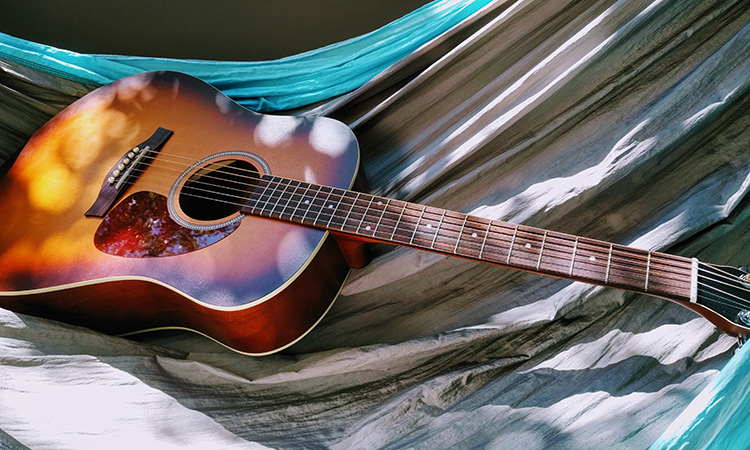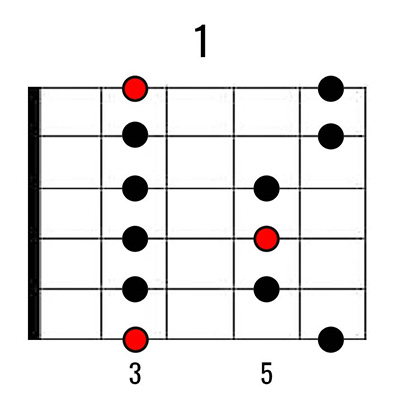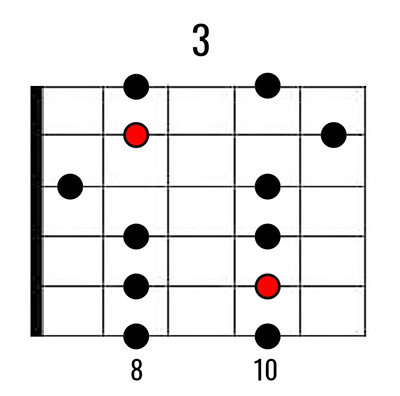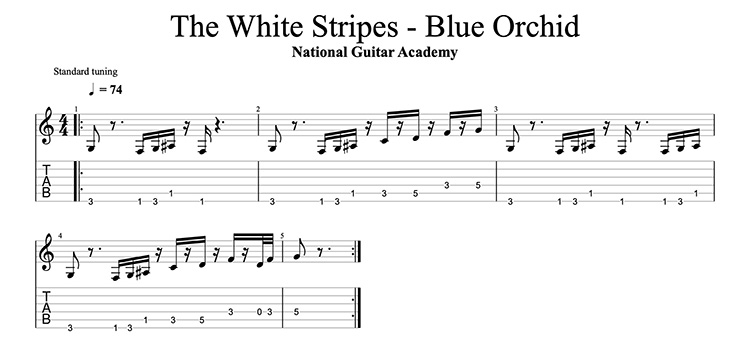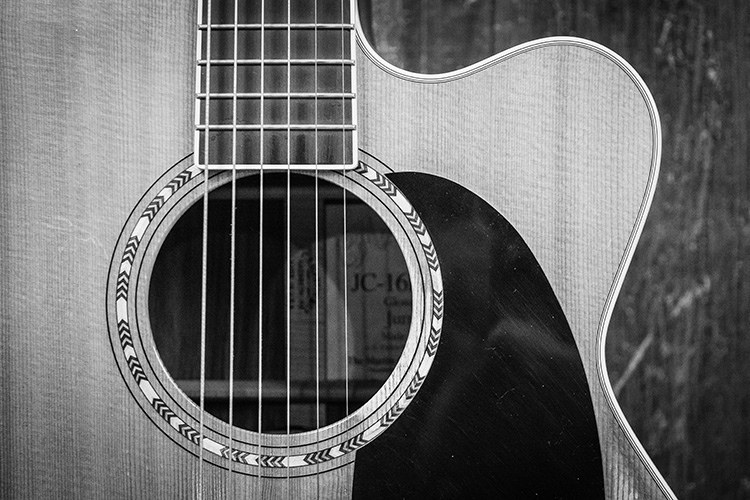The G minor pentatonic scale is easily one of the coolest scales around. Whether you want to be rock, blues or country guitarist, this versatile scale is a must-know for any guitarist!
Over 100,000 guitar-learners get our world-class guitar tips & tutorials sent straight to their inbox:
Click here to join them
Get our best guitar tips & videos
In this free lesson you will learn:
- All 5 positions of the G minor pentatonic scale.
- 3 quick & easy scale tips that will make you sound incredible.
- The no1 secret that will help you use the G minor pentatonic scale in ANY musical situation.
What is a Pentatonic Scale?
The pentatonic scale is a five-note scale which is used across many genres of music.
- The minor pentatonic scale is based on the minor scale. However, the minor scale has 7 notes and the minor pentatonic scale has 5.
- The best way to think about the minor pentatonic scale is to think of it as a ‘minor scale in an abridged form’.
- Every pentatonic scale out there can be broken down into ‘boxes’. A ‘box’ pattern is simply a different place where you can play the scale on the fretboard.
Because the pentatonic scale has five notes, this means that there are 5 different ‘boxes’ available to us as guitarists.
Let’s take a look at how we can use the G minor pentatonic scale and then we’ll break down each box pattern from there.
G Minor Pentatonic Scale – When to Use It
The pentatonic scale itself is used widely in genres like rock and roll, blues, and country music.
In G minor pentatonic however, it has a bit more bite to it than it has in other keys. Compared to the A minor pentatonic scale, G minor is a bit rowdier.
This specific key of the pentatonic scale is great for groove-based rock and blues songs that make you want to tap your feet and bob your head.
The notes of the scale are as follows:
G – Bb – C – D – Eb – F
The chords for the key of G minor itself are:
• G minor.
• A diminished.
• Bb major.
• C minor.
• D minor.
• Eb major.
• F major.
G minor is very much a rock and roll-style key, and the main example that we’ll be looking at today reflects that.
- In a soloing context, the G minor pentatonic scale can be played over a few different keys including G minor, Bb major and G major.
- Because these other keys share the same notes, they are able to be played over one another.
Skill Tip: Remember when soloing to pay close attention to the chord changes to get the best idea of what to play next!
Download our lead guitar cheat-sheet to make things easier
It's hard to understand which scales work with which keys.
So we created a cheat-sheet! A key and scale-finder that you can use again and again.
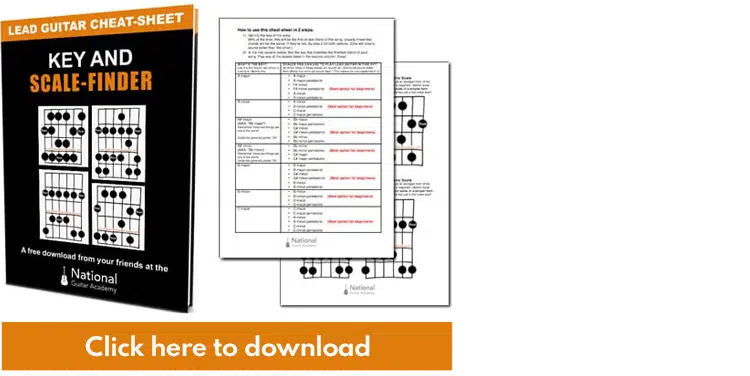
Get your personalised guitar-learning plan 🎸
Get a custom guitar-learning plan here: Click here for GuitarMetrics™
World-Class Guitar Courses 🌎
Learn from the world's best guitar educators: Click here for our guitar courses
The Five Boxes
Most scales will pop up in five main positions across the fretboard.
- The position in which our index finger plays the first note of the scale (aka the ‘root note’) is called the root position.
- Each of the following positions will be slightly different than the last, but remember that all of the notes are the same throughout.
Each position after the root position begins on a different note of the scale.
Like this:
• Root Position: 3rd fret (G)
• Second Position: 6th fret (Bb)
• Third Position: 8th fret (C)
• Fourth Position: 10th fret (D)
• Fifth Position: 13th fret (F)
The important thing to remember with these exercises is to stretch before you practice.
- This ensures that we play effectively and prevent straining our hands, wrists and forearms in the process.
- Before we begin, let’s look at what the entire fretboard looks like.
- As we progress through this lesson, you can refer back to this diagram to see how each scale shape shares notes with the others in the G minor pentatonic scale.
Skill Tip: The key to playing scales effectively is to play them slow, applying a good amount of pressure to the strings at each fret. We want to make each note sound clear and concise as we play through the scale.
G Minor Pentatonic Scale – Root Position (G)
The first shape of the G minor pentatonic scale is comfortable and easy to play.
- When we play scales, it is important to assign one fret of the scale shape to each finger.
- This is convenient because most scale shapes occur in four-fret shapes.
- Occasionally (only once in the pentatonic scale) we will have to stretch our fingers one fret above or below those four frets, but that’s why we have pinky fingers!
For this first position, we only need three fingers and we can position them like so:
• 3rd fret – Index
• 5th fret – Ring
• 6th fret – Pinky
Using our pinky finger can be difficult at first, but it’s important to incorporate it into your playing early on. Stretching can help alleviate any discomfort this may cause.
Skill Tip: Try to focus on alternate picking when playing these scale shapes. Developing a fluid back-and-forth motion in the picking hand helps build good habits.
If you’d like to learn more about alternate picking, go here: Alternate Picking: The Ultimate Guide
G Minor Pentatonic Scale – Box Shape #2 (Bb)
The second shape of this scale begins at the 6th fret, and leans on the middle finger for support.
- This shape of the G minor pentatonic scale starts with the middle finger on the 6th fret, but we move back to the 5th fret once we reach the A string.
- By assigning one finger to each fret, we can use our index finger on the 5th frets of each string and avoid shifting hand positions.
Skill Tip: This particular scale shape is great for working on finger independence, as we cannot solely rely on our index finger for balance. Try to keep an open hand position when playing this shape, and avoid tensing your fret hand.
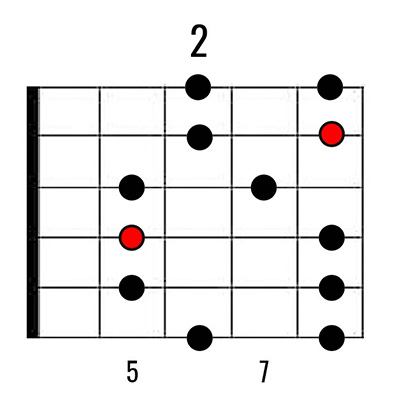
G Minor Pentatonic Scale – Box Shape #3 (C)
Position #3 gives our hands a bit of a stretch, but thankfully you’re already warmed up from the exercises above.
We can either start with our index or middle finger because this position is five frets in length.
We’ll let you decide what’s most comfortable for your hand, but we will either have to move forward or backward one fret to accommodate the stretch.
Practicing the movement of our fingers between the strings helps us get used to navigating these scale shapes, so take your time and try to play as clean as possible.
Skill Tip: It’s very wise to make use of our pinky finger here as much as possible, specifically on the G and B strings. Getting used to these stretches early on will help us build fantastic strength in our fretting hand.
G Minor Pentatonic Scale – Box Shape #4 (D)
This next scale shape is very similar to the root position with a few slight adjustments, including the use of our middle finger.
- We begin with our index finger on the 10th fret of the low E string and we follow with our pinky finger, climbing this shape of the G minor pentatonic scale slowly.
- Remember that although the positions may be similar, the order of the notes changes with each shape.
Skill Tip: Pay close attention to where the root note (G) occurs in each scale shape.
Keeping track of our root notes throughout our practice gives us a compass to navigate the fretboard with.
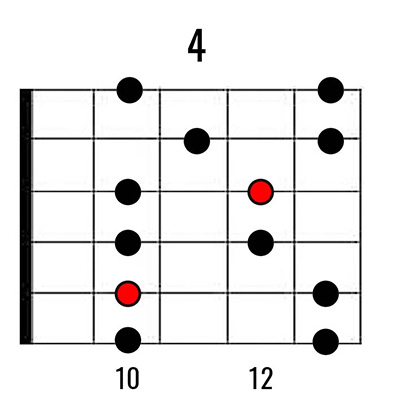
G Minor Pentatonic Scale – Box Shape #5 (F)
The final shape of the G minor pentatonic scale starts at the 13th fret.
- Because not every guitarist can get past the 12th fret of their guitar, we can also play this position starting at the 1st fret, using the open strings as a replacement for the 12th fret.
- The open strings and 12th fret notes are the same, which makes this super easy.
Regardless of where you play it, this scale shape is similar to shape #2, with a few minor adjustments. Start out with your middle finger so that your index is free for the shift to the 12th fret on the D string.
Our ring finger unfortunately won’t get much of a workout on this shape of the G minor pentatonic scale, but our other three fingers will get a great chance to work together.
Rockstar Skill Tip: As we have discussed, each shape of the G minor pentatonic scale begins on a different note. Because of this, each shape has its own character to it when used in a soloing context.
Try playing each shape over a jam track to get a feel for what sounds each one offers you, and then try connecting each section together.
Through efficient practice, this will help you develop a seamless ‘mental map’ of the G minor pentatonic scale.
Always work toward memorization, and connect the dots to what you already know when you learn something new. Give it a shot here:
Learn 12 EASY beginner chords with our popular guide


Where should we send it?
✅ Stop struggling. Start making music.
✅ Learn beginner-friendly versions of every chord.
This is our most popular guide and it will improve your chord ability quickly! 😎
Get your own personalised guitar-learning plan 🎸
Get a custom guitar-learning plan here: Click here for GuitarMetrics™
World-Class Guitar Courses 🌎
Learn from the world's best guitar educators: Click here for our guitar courses
Connecting The Shapes of the G Minor Pentatonic Scale
Learning scale shapes in individual boxes does wonders for our playing.
If you want to be serious though, you’re going to want to connect the individual shapes together.
Connecting the shapes of the G minor pentatonic scale together becomes a lot easier when we begin by practicing the shapes individually first, so make sure you’ve taken some time with the exercises above before moving forward.
We’re going to look at a cool riff that connects the first and second scale shapes together. We’re going to make this fun by incorporating sliding into our playing here.
If you’ve never done this before, begin by practicing sliding your ring finger from the 5th to 7th fret on any string, then back.
You’ll want the string to keep ringing out as you move from one note to the other, so don’t be afraid to practice this technique for a while.
Now that we’ve got sliding down, let’s jump into the example below:
This is a fantastic way of transitioning between each pentatonic position.
If you fancied an extra challenge you could experiment with sliding in the other pentatonic positions to see if you could link the patterns together.
Case Study – The White Stripes – ‘Blue Orchid’
Jack White leans heavily on the root position of the G minor pentatonic scale for this explosive rock and roll anthem.
- Blue Orchid sounds like quite a bit to take in on the first listen, but breaking the individual riffs down into smaller sections will help us conquer the riffs in this lesson in no time.
As an added bonus, this song teaches us some great rhythms and is a ton of fun to jam to.
Skill Tip: You are going to want to practice “bar to bar” for this song in order to easily string the sections of ‘Blue Orchid’ together. This means that instead of practicing larger sections all at once, we practice those sections one bar at a time. This is a common and extremely effective practice technique that can help skyrocket your playing and understanding.
- Practicing bar-to-bar in four-bar sections helps us keep making sense of what we’re playing and not get lost along the way.
- We’ve included bar lines in the tab so you can practice in this way.
Check it out below:
Rather than starting on the index finger like we do in the root position, we can start with our ring finger on the 3rd fret (E string) to make it easy to move back to the first fret after.
When we move up to the 5th fret, we can shift our whole hand up to the third fret to make it easier to play the bars that follow.
Shifting hand positions when necessary helps us prevent strain on our hands, and keeps our playing smooth and clean.
Skill Tip: At the end of the fourth bar, we can play the last two notes of the bar together with the first note on the fifth. These three notes happen quickly, and we immediately fall back to the start of the riff after. Make sure you’re listening intently for the changes, this song is excellent practice for ear training as well as playing the G minor pentatonic scale
Bonus Tone Tip: Jack White is a master of weird guitar pedals.
- If you haven’t seen it, you should watch It Might Get Loud, where he sits down with Jimmy Page (Led Zeppelin) and The Edge (U2) to talk about gear and songwriting.
- In Blue Orchid, White uses an Octave pedal tuned down an octave and up a fifth in order to get that wide and crazy sounding guitar tone that you’re hearing.
- Give it a shot if you’ve got an octave pedal, as well as this fuzz pedals also work great for this song.
If you’re just running straight into your amp, you can just your distortion channel. Keep the gain knob at 40-50% and you’ll be rocking in no time.
Where Do I Go From Here?
Want to keep the ball rolling on your guitar adventure?
We recommend:
• Taking what you’ve learned to your guitar teacher and discussing it.
• Jamming with your friends in G minor.
• Find more backing tracks on Youtube and play over them.
• Read more free articles on guitar.
• Start a practice journal and log your practice routine.
Recommended Resources
If you’re looking for more scales to practice, check out some more of our free lessons below!
• A Minor Pentatonic Scale: An Essential Guide
• Learning Guitar Scales – A Three-Step Guide
• E Minor Pentatonic Scale: The Ultimate Guide
• Guitar Scales Tabs: The Ultimate Guide
• Basic Guitar Scales: 7 Scales You Must Know
What Type of Guitarist Are You?
Take our 60-second quiz & get your results: Take The Quiz
Join the world's best online guitar school 🌎
- Get your own personalised guitar learning plan (customised just for YOU).
- World-class online guitar courses. Learn at your own pace.
- Community Campus & Learning Forum - A friendly community! Connect with our team & students. 😊
- Beginner Song library with chordsheets, tabs and tips. (Songs suitable for all levels!)
- Regular live streams, seminars and Q&A sessions - Learn from world-class guitar educators. Get all your questions answered!
Click here to learn more about National Guitar Academy membership 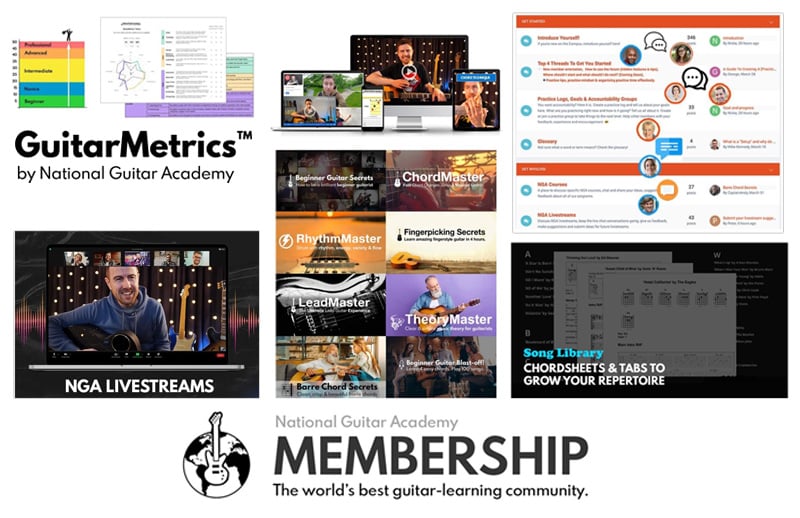
Cool Guitar T-shirts 😎
Look cooler! Check out our merch: Click here to see our merch store
Want free guitar tips and video lessons delivered to your inbox?
Join over 100,000 guitar-learners and subscribe to our guitar-tips-by-email service. (It's free.)
We'll send you a series of lessons that will move you to the next level of your guitar journey.
Learn how everything fits together quickly, easily and effectively. We share ninja tips (for instant fun!) but also timeless fundamentals that will deepen your understanding.


Get our best guitar tips & videos
Popular Lessons
How To Learn Guitar: An 11-Step Programme For Beginners
How To Choose The Perfect Beginner Guitar
More Cool Guitar Stuff
Learn about National Guitar Academy: About Us
Join us on Facebook for daily guitar tips.
Listen to our Learn Guitar Podcast for rapid guitar progress.
Check out our free chord lessons.





